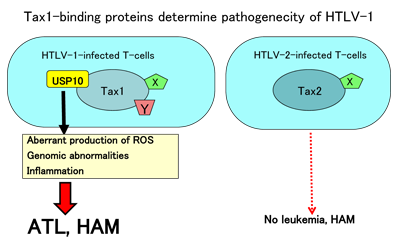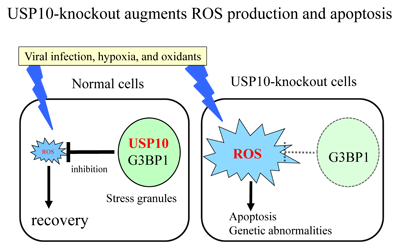1.Research Summary
In the field of virology, we conduct research on the pathogenesis of leukemia and myelopathy by human T-cell leukemia virus 1 (HTLV-1) infection and the therapies against these diseases.
2.Research Subjects
3.Research Results
[Area] Virology
[Research subject]
Pathogenesis of leukemia due to HTLV-1
[Description]
HTLV-1 is the causative agent of adult T-cell leukemia (ATL) and HTLV-1-associated
myelopathy (HAM), whereas the similar virus HTLV-2 is not involved in these
diseases. We clarified that the virus protein Tax1 is responsible for this
difference. We identified multiple host factors interacting with Tax1 but
not HTLV-2 Tax2 to mediate the difference between HTLV-1 and HTLV-2, and
have been analyzing their functions (Research subject 2). We are striving
to develop therapeutic agents for ATL and HAM targeting to Tax1-interacing
proteins such as USP10.
[Photographs]

[Area] Virology
[Research subject]
Mechanism for control of stress response by stress granules
[Description]
Reactive oxygen species (ROS), produced by stresses, including virus infection,
hypoxia, ultraviolet rays and oxidants, cause various cellular abnormalities
(DNA damage, accumulation of abnormal proteins, etc.) and are involved
in carcinogenesis, aging, and neurodegeneration. We have succeeded in identifying
two proteins, USP10 and G3BP1, which inhibit the production of ROS induced
by these stresses. USP10 inhibits the production of ROS, but in a steady
state, this action is inhibited by G3BP1. When normal cells are subjected
to stress, USP10 and G3BP1 form large complexes called as stress granules,
which reduce the production of ROS and ROS-dependent cell death. Thus,
USP10-depeletion induces aberrant ROS production.
[Photographs]

Please see the Virology website for a detailed description of our research.
